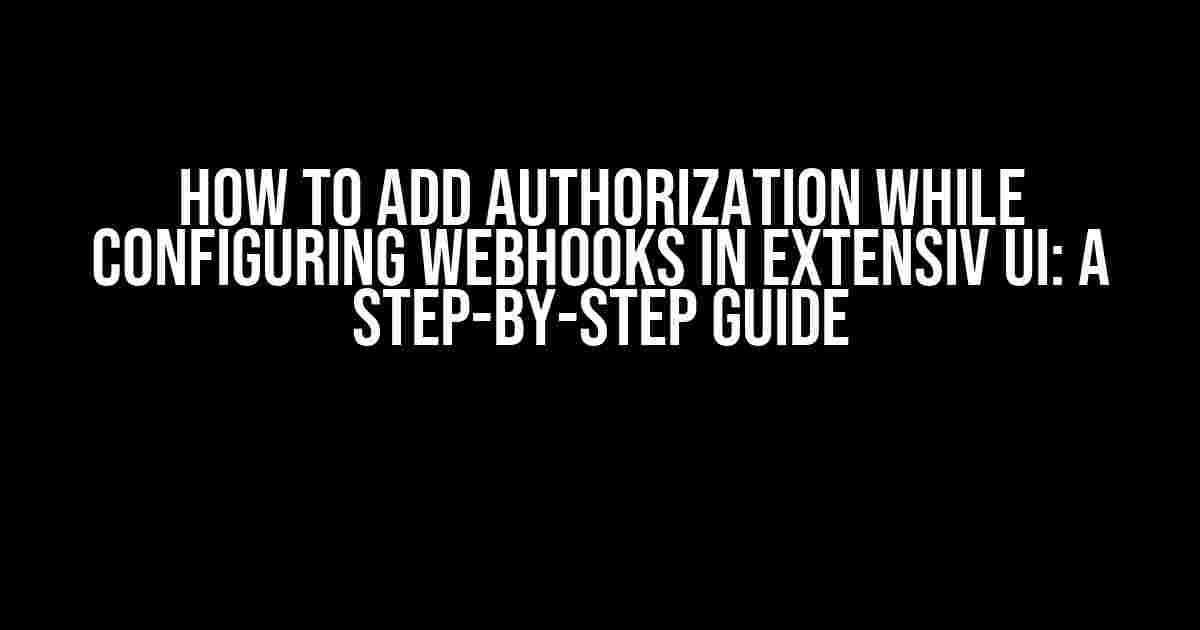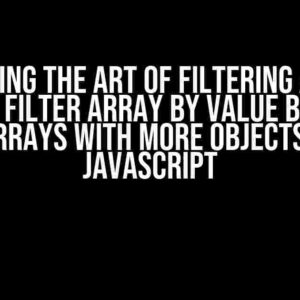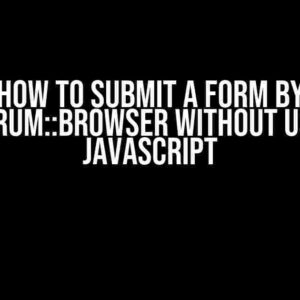Webhooks are an essential part of integrating Extensiv with other applications, allowing real-time communication and automating workflows. However, ensuring the security and authenticity of these webhooks is crucial. In this article, we’ll take you through the process of adding authorization while configuring webhooks in Extensiv UI, making sure your integrations are secure and reliable.
Understanding Webhooks and Authorization
Before diving into the configuration process, let’s quickly cover the basics of webhooks and authorization.
What are Webhooks?
Webhooks are a type of API callback that allows one application to provide real-time notifications to another application whenever a specific event occurs. In the context of Extensiv, webhooks enable you to receive notifications when a shipment is created, updated, or delivered, among other events.
What is Authorization?
Authorization is the process of verifying the identity of a requestor and determining whether they have the necessary permissions to access a particular resource. In the context of webhooks, authorization ensures that only authorized parties can trigger or receive notifications.
Why is Authorization Important for Webhooks?
Without proper authorization, webhooks can be vulnerable to unauthorized access, data tampering, and denial-of-service attacks. Here are some reasons why authorization is crucial for webhooks:
- Data Security: Webhooks often involve sensitive data, such as shipment details, customer information, and order updates. Authorization ensures that this data is protected from unauthorized access.
- Prevention of Abuse: Unauthorized webhooks can lead to abuse, such as spamming or overwhelming your system with unnecessary requests. Authorization helps prevent these types of attacks.
- Audit Trail: With authorization, you can track and monitor webhook requests, making it easier to identify and troubleshoot issues.
Adding Authorization to Webhooks in Extensiv UI
Now that we’ve covered the importance of authorization, let’s walk through the step-by-step process of adding authorization to webhooks in Extensiv UI.
Step 1: Create an API Key
Before configuring webhooks, you need to create an API key in Extensiv UI. This key will be used to authenticate and authorize webhook requests.
API Key Creation Steps:* 1. Log in to your Extensiv UI account. 2. Navigate to theIntegrationstab. 3. Click on theAPI Keyssection. 4. Click theCreate API Keybutton. 5. Fill in the required information, such as key name and description. 6. Click theCreate API Keybutton to generate the key.
Step 2: Configure Webhook Settings
Next, you need to configure the webhook settings in Extensiv UI.
Webhook Configuration Steps:* 1. Navigate to theIntegrationstab. 2. Click on theWebhookssection. 3. Click theCreate Webhookbutton. 4. Fill in the required information, such as webhook name, URL, and events. 5. In theAuthenticationsection, selectAPI Keyas the authentication method. 6. Enter the API key created in Step 1. 7. Click theCreate Webhookbutton to save the configuration.
Step 3: Implement Authentication on the Webhook Endpoint
Now that you’ve configured the webhook settings in Extensiv UI, you need to implement authentication on the webhook endpoint.
Webhook Endpoint Authentication Example:*
// Node.js Example using Express.js
const express = require('express');
const app = express();
app.post('/webhook', (req, res) => {
const apikey = req.headers['x-api-key'];
if (!apikey || apikey !== 'YOUR_API_KEY_HERE') {
return res.status(401).send({ error: 'Unauthorized' });
}
// Process the webhook request
res.send({ message: 'Webhook received successfully' });
});
app.listen(3000, () => {
console.log('Webhook endpoint listening on port 3000');
});
Common Authorization Scenarios for Webhooks
Here are some common authorization scenarios for webhooks:
Scenario 1: Basic Authentication
In this scenario, the webhook endpoint expects a basic authentication header with a username and password.
Basic Authentication Example:*
// Node.js Example using Express.js
const express = require('express');
const app = express();
const basicAuth = require('express-basic-auth');
app.use(basicAuth({ users: { 'username': 'password' } }));
app.post('/webhook', (req, res) => {
// Process the webhook request
res.send({ message: 'Webhook received successfully' });
});
Scenario 2: Token-Based Authentication
In this scenario, the webhook endpoint expects a token-based authentication header with a unique token.
Token-Based Authentication Example:*
// Node.js Example using Express.js
const express = require('express');
const app = express();
const jwt = require('jsonwebtoken');
app.post('/webhook', (req, res) => {
const token = req.headers['x-auth-token'];
if (!token) {
return res.status(401).send({ error: 'Unauthorized' });
}
const decoded = jwt.verify(token, 'YOUR_SECRET_KEY_HERE');
if (!decoded) {
return res.status(401).send({ error: 'Unauthorized' });
}
// Process the webhook request
res.send({ message: 'Webhook received successfully' });
});
Best Practices for Authorizing Webhooks
Here are some best practices to keep in mind when authorizing webhooks:
- Use Secure Tokens: Use secure tokens that are difficult to reverse-engineer or guess.
- Implement Rate Limiting: Implement rate limiting to prevent abuse and denial-of-service attacks.
- Monitor Webhook Activity: Monitor webhook activity to detect and respond to potential security issues.
- Use HTTPS: Use HTTPS to encrypt webhook requests and responses.
- Restrict IP Addresses: Restrict webhook requests to specific IP addresses or networks.
Conclusion
In this article, we walked you through the process of adding authorization while configuring webhooks in Extensiv UI. By following these steps and best practices, you can ensure that your webhooks are secure, reliable, and authorized. Remember to always prioritize security and authentication when working with webhooks to prevent potential security breaches.
| Keyword | Description |
|---|---|
| Authorization | The process of verifying the identity of a requestor and determining whether they have the necessary permissions to access a particular resource. |
| Webhook | A type of API callback that allows one application to provide real-time notifications to another application whenever a specific event occurs. |
| API Key | A unique key used to authenticate and authorize API requests. |
| Extensiv UI | A platform that enables you to integrate and automate workflows between multiple applications and services. |
*Please note that the examples and code snippets provided in this article are for illustrative purposes only and may require modification to fit your specific use case.
Here are 5 Questions and Answers about “How to add Authorization while configuring webhooks in Extensiv UI”:
Frequently Asked Question
Get answers to your questions about configuring webhooks with authorization in Extensiv UI!
What is the purpose of authorization when configuring webhooks in Extensiv UI?
Authorization is an essential step in configuring webhooks in Extensiv UI as it ensures that only authorized parties can send data to your webhook endpoint. This adds an extra layer of security to your integration, preventing unauthorized access and potential data breaches.
What types of authorization methods are supported by Extensiv UI for webhooks?
Extensiv UI supports several authorization methods for webhooks, including API keys, basic authentication, OAuth 2.0, and JSON Web Tokens (JWT). You can choose the method that best fits your integration requirements.
How do I generate an API key for authorization in Extensiv UI?
To generate an API key in Extensiv UI, navigate to the “Integrations” section, click on “API Keys,” and then click the “Create API Key” button. Fill in the required information, and your API key will be generated. You can then use this key to authenticate your webhook requests.
Can I use OAuth 2.0 for authorization with webhooks in Extensiv UI?
Yes, Extensiv UI supports OAuth 2.0 for authorization with webhooks. You can configure OAuth 2.0 by creating an OAuth client ID and secret, and then using them to authenticate your webhook requests. This provides an additional layer of security and flexibility for your integration.
What happens if I don’t add authorization to my webhook configuration in Extensiv UI?
If you don’t add authorization to your webhook configuration in Extensiv UI, your webhook endpoint will be open to anyone, making it vulnerable to unauthorized access and potential data breaches. This can lead to security risks and compromise the integrity of your integration.





